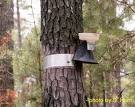Shortleaf Pine Tree Information
Images of Shortleaf Pine:






Shortleaf Pine grows in the following 16 states and provinces:
Alabama, Arkansas, Delaware, Florida, Georgia, Hawaii, Louisiana, Maryland, Mississippi, New Jersey, North Carolina, Oklahoma, South Carolina, Tennessee, Texas, VirginiaInformation about Shortleaf Pine:
The Pinus Taeda is commonly known as the Arkansas Pine, Loblolly Pine, North Carolina Pine, Old Field Pine as well as Shortleaf Pine.
The currently accepted scientific name of loblolly pine is Pinus taeda L. . There are no recognized subspecies, varieties, or forms. Loblolly pine forms hybrids with shortleaf pine (P. echinata), longleaf pine (P. palustris), pitch pine (P. rigida), slash pine (P. elliottii), and pond pine (P. serotina) .Loblolly pine is widely distributed in the southeastern United States from southern New Jersey to central Florida and west through the Gulf States to eastern Texas. It also occurs in southeastern Oklahoma, central Arkansas, and southern Tennessee. It is found in the Piedmont Plateau, the Atlantic Coastal Plain, the southern extent of the Cumberland Plateau, and the Valley-and-Ridge Province of the Appalachian Highlands .Published classifications listing loblolly pine as a dominant species in community types are presented below. Eastern deciduous forest, Vol. 1: Southeastern evergreen and oak-pine region Plant communities of the Coastal Plain of North Carolina and their successional relations The natural communities of South Carolina Common overstory associates of loblolly pine include southern red oak (Quercus falcata), white oak (Q. alba), blackjack oak (Q. marilandica), post oak (Q. stellata), water oak (Q. nigra), willow oak (Q. phellos), laurel oak (Q. laurifolia), sassafras (Sassafras albidum), persimmon (Diospyros virginiana), American beech (Fagus grandifolia), spruce pine (Pinus glabra), blackgum (Nyssa sylvatica), red maple (Acer rubrum), southern magnolia (Magnolia grandiflora), American elm (Ulmus americana), water hickory (Carya aquatica) and white and Carolina ash (Fraxinus americana and F. caroliniana) . Common understory shrubs and trees include flowering dogwood (Cornus florida), American holly (Ilex opaca), inkberry (I. glabra), yaupon (I. vomitoria), hawthorn (Crataegus spp.), southern bayberry (Myrica cerifera), pepperbush (Clethra spp.), and sumac (Rhus spp.) . Common herbaceous species include bluestem (Andropogon spp.), panicum (Panicum spp.), sedges (Carex spp. and Cyperus spp.), and fennel (Eupatorium spp.) .Some of the information provided here is attributed to:Carey, Jennifer H. 1992. Pinus taeda. In: Fire Effects Information System, [Online]. U.S. Department of Agriculture, Forest Service, Rocky Mountain Research Station, Fire Sciences Laboratory (Producer). , available at the USDA Fire Effects Information System (FEIS) website